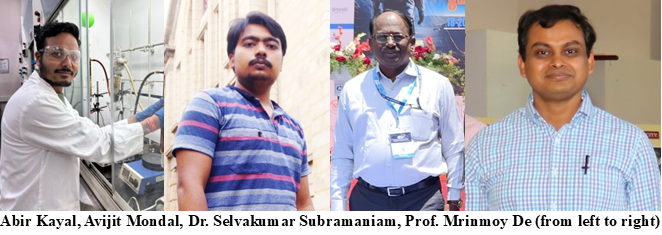Reusable aerogel that absorbs harmful HCl gas
–Pratibha Gopalakrishna

When rockets are launched, they leave behind a plume of gases, a major component of which is hydrochloric acid (HCl) gas. Along with the other gases, HCl plays a key role in acidifying the local atmosphere, contributing to acid rain and affecting air quality, plants, animals, and water bodies near the launch site. To address this problem, researchers at the Department of Organic Chemistry (OC), IISc led by Mrinmoy De, in collaboration with Selvakumar Subramanian at ISRO, have developed a reusable aerogel made of Molybdenum disulphide (MoS2) engineered to absorb HCl gas. MoS2 is typically thrown away as industrial waste; it is therefore an inexpensive starting material for aerogel preparation.
In their paper published in ChemistrySelect, the team freeze-dried a solution of ammonium tetrathiomolybdate to form a brownish red coloured 3D structure. This structure was then annealed with a 2% hydrogen-argon gas mixture to form the final black-coloured MoS2 aerogel.
The researchers then tested various properties of the aerogel, including its gas absorption efficiency. Scanning Electron Microscope (SEM) images of the aerogel showed that it is highly porous and has 2D layers, both of which can help absorb HCl gas better. The aerogel is reusable, environment-friendly, and so lightweight that it can be placed on a flower, according to the authors.
On testing the efficiency of the aerogel, the researchers found that it absorbs 65.88% of HCl from the atmosphere. Interestingly, the researchers noted that the MoS2 layers break the hydrogen and chlorine bond as it absorbs the HCl molecules, which leads to higher absorption. The material is currently being tested to see how well it can absorb HCl gas at launch pads sites.

REFERENCE:
Kayal A, Mondal A, Subramanian S, De M, Facile Synthesis of a Reusable MoS2 Aerogel for Efficient HCl Gas Absorption, ChemistrySelect (2024).
https://chemistry-europe.onlinelibrary.wiley.com/doi/10.1002/slct.202403662
LAB WEBSITE:
https://orgchem.iisc.ac.in/mrinmoy_de/index.html





